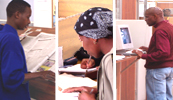
| Evaluating the information |
 |




- Primary vs secondary sources
- Critical reading
Critial reading
 |
What is critical reading?Let's look at some definitions: Critical reading is to "make judgments about how the text
is argued". "Critical reading is a technique for discovering information
and ideas within a text." |
In other words critical reading is all about understanding what the author is saying, following his/her argument and looking for evidence that supports the author's viewpoint. Most important of all do not believe everything you read. Check it to see if it is logical.
Practical tips:
- Begin your reading by skimming the material. You do that by reading the introduction, summary, conclusions, headings, etc. Highlight what is important to you.
- Determine the purpose of the text. What is the author trying to say, what is the purpose of the article, book, etc.
- Make judgments about the context. Who is the intended audience of the text? What is the viewpoint of the author? Is the author biased in any way? Is there a logical flow of text?
- Examine the evidence. What evidence is given for statements,
opinions, etc. Analyse the evidence. How is the evidence used in the
text? Look for examples.
(Source - adapted: http://www.utoronto.ca/writing/critrdg.html, 2001)
Other very useful web sites on critical reading:
 |
What is critical reading? (Dan Kurland's)
Critical reading v. critical thinking (Dan Kurland's)
Critical reading techniques (Pearson Education)
